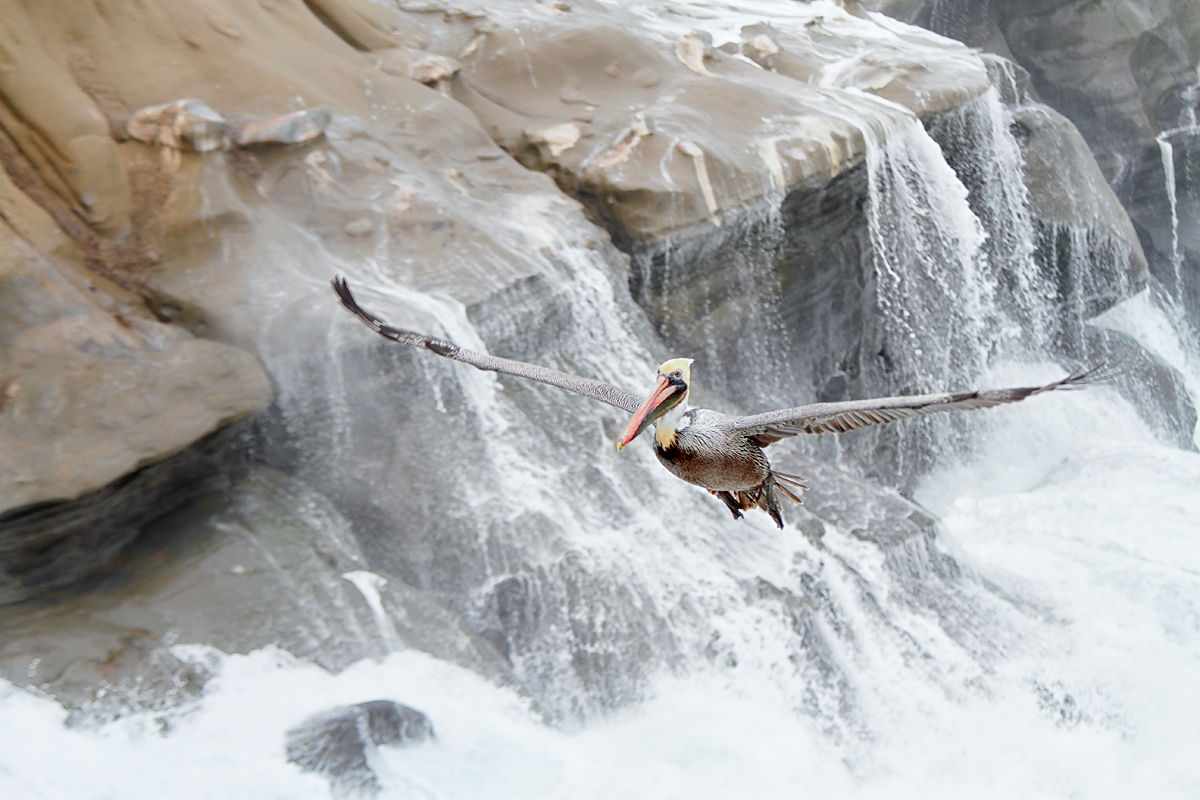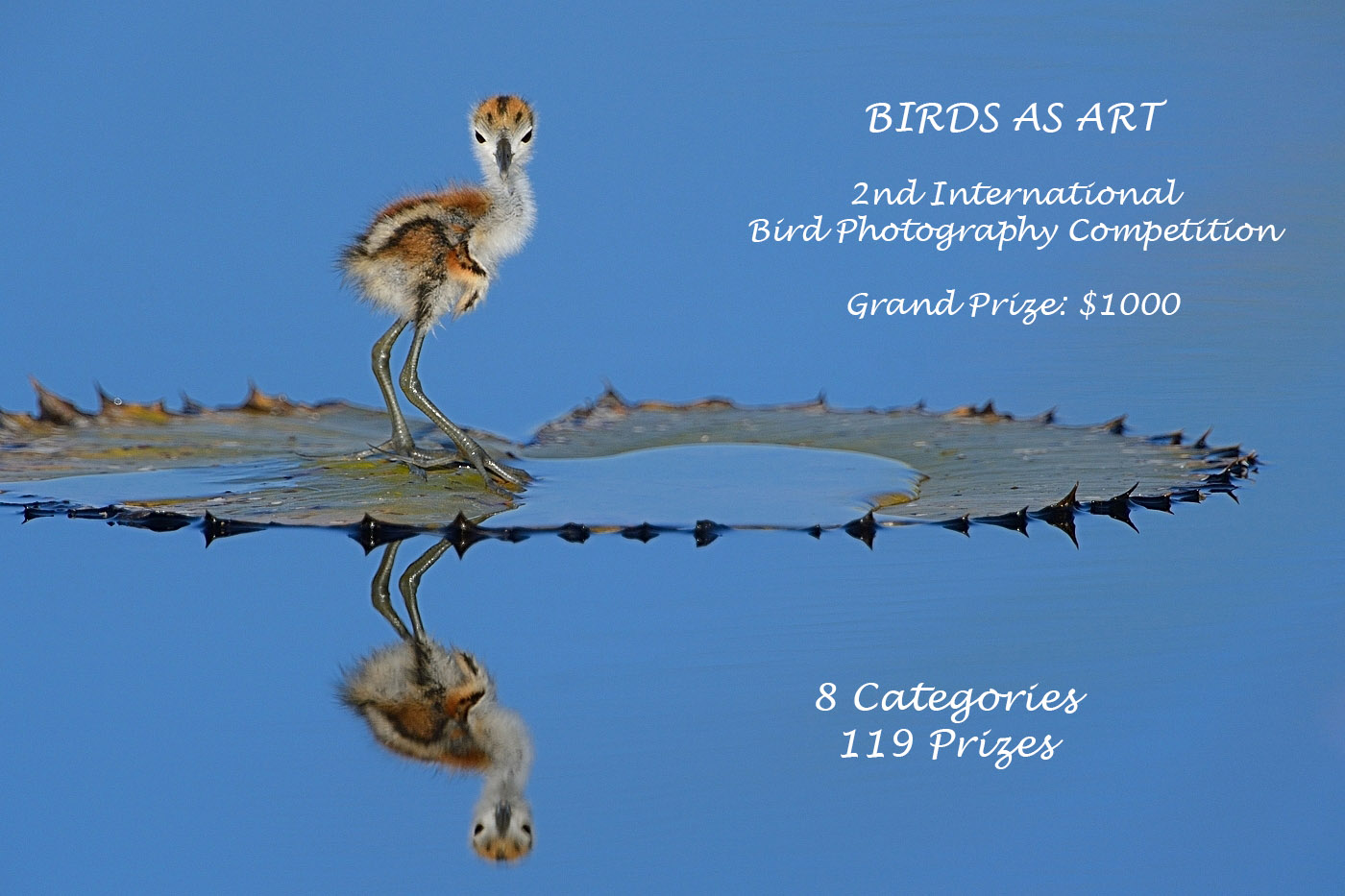
|
|
This Brown Pelican image was created in January, 2010 with the Canon EF 70-200mm f/2.8L IS II USM lens (hand held at 108mm) and the EOS-7D (now replaced for me by the Canon EOS 5D Mark III Digital camera body). ISO 500. Evaluative metering +2 1/3 stops off of the cloudy white sky: 1/500 sec. at f/5.6 in Manual mode. Central Sensor AI Servo Rear Focus AF as framed active at the moment of exposure. Click here to see the latest version of the Rear Focus Tutorial. Be sure to click on the image to enjoy a larger version. |
The #1 Reason to Work in Manual Mode for Flight Photography
It’s simple. If the possibility of rapidly changing background tonality exists (as it almost always does with flight photography), you need to be in Manual mode to ensure the correct exposure for the bird. If I had been working in Av mode for this image, the camera would have seen all of that white water on a cloudy day and would have severely underexposed the RAW file. And that is the last thing that you would ever want to do with the small pixels of the EOS-7D. If you lighten an underexposed image you are simply increasing the noise. That is why learning to Expose to the Right (ETTR) is more than important. It too is mandatory and imperative….
The above, however, does not mean that you should be working in Manual mode all the time. That is a myth. To learn the whole story, see the “At Long Last, As Promised: the Greatest, Most Educational Blog Post Ever? Manual… Av… Tv… Program… Which is The Best Shooting Mode?” blog post here. What is the best plan? Bookmark it and study it. Often.
Do understand that if you do not understand exposure theory, if you do not know how to work in Manual mode–don’t be scared it’s really the same as Av and Tv, and if you do not know how to check for blinkies, analyze a histogram, and adjust your exposure parameters you will not consistently come up with perfect exposures. Being in one mode or another does not guarantee a proper exposure unless you are well-versed as above. To learn to get the right exposure every time I recommend getting the 2-Book Bundle. In The Art of Bird Photography (the original ABP in soft cover–the classic how-to book on bird photography) you will need to study the Exposure chapter and most especially the section on Exposure Theory. In The Art of Bird Photography II (ABP II: 916 pages, 900+ images on CD only), you will need to study Exposure Simplified and all 900+ of our educational image captions. Each explains how I metered and how I compensated in order to come up with a workable exposure in short order.
Image Questions
#1: If I had been using the 5D Mark III for this image what would I have had to have done differently?
#2: Why did I selectively apply a 100% layer of NIK Detail Extractor and a small Linear Burn to this image?
|
Join me in San Diego for three great days of photography and learning. Click on the image to better enjoy a larger version. |
Only 1 Slot Open!
The San Diego Short-Notice Small Group IPT. January 15-17, 3-Full Days: $1049. Meet and Greet after dinner on your own at 7:30pm on Tuesday, January 14, 2014. Limit 6/Openings: 1.
We will get to photograph the California race of Brown Pelican in flight, resting, preening, cleaning their bill pouches, and talking to their neighbors by tossing their bills high in the air. The afternoon sessions will feature Marbled Godwits, several gull species, and Wood and Ring-necked Ducks. If we have a cloudy morning we will get to photograph Harbor Seals. You will learn to get the right exposure every time, to see the best situation, to think like a pro, to create sharp, pleasing images, and to understand the joint effects of light and wind on the birds. All in a small group with tons of individual attention.
A $500 non-refundable deposit is required to hold your slot for this IPT. Your balance will be due no later than January 7, 2014. The balance is also non-refundable. If the trip fills, we will be glad to apply a credit applicable to a future IPT for the full amount less a $100 processing fee. If we do not receive your check for the balance on or before the due date we will try to fill your spot from the waiting list. If your spot is filled, you will lose your deposit. If not, you can secure your spot by paying your balance.
If you are planning to register please shoot me an e-mail.
Then please print, complete, and sign the form that is linked to here and shoot it to us along with your deposit check (made out to “Arthur Morris.”) Though we prefer a check, you can also leave your deposit with a credit card by calling the office at 863-692-0906. If you register by phone, please print, complete and sign the form as noted above and either mail it to us or e-mail the scan.
If you have any questions, please feel free to contact me via e-mail
San Diego Site Guide
Can’t make the IPT? Get yourself a copy of the San Diego Site Guide; it’s the next best thing to being on an IPT. Nearly 30 years of San Diego bird photography revealed in one fell swoop.
IPT Info
Many of our great trips are filling up. You will learn more about how to make great images on a BAA IPT than anywhere else on the planet. Click here for info on the Anhinga Trail IPT. Click here for info on the Estero Lagoon IPT. And click here to learn about the just-announced 2014 Bosque IPTs. You will find additional IPTs and general info here.
Great Buy: Used Canon 800mm f/5/6L IS Lens for Sale
Friend and multiple IPT-veteran Monte Brown is offering his lightly used Canon 800mm f/5.6L IS lens in excellent condition for sale for $9,500. Purchase includes the lens case and hood, the 4th Generation Design Low Foot, the original foot, a LensCoat, the original invoice and the original Canon shipping carton. The lens was purchased new from B&H in April 2009 and was recently underwent a pre-sale clean and check by Canon. The buyer pays insured shipping via UPS Ground to US addresses only. The lens will be shipped only after your check clears.
The Canon EF 800mm f/5.6L IS USM Autofocus lens sells new for $13,223.00 so you will save a bundle on a great lens. No need to ever use a 2X…
If interested you can contact Monte by phone at 1-765-744-1421 or via e-mail.
Last Year’s Grand Prize winning image by Lou Coetzer

|
Time is Running Out!
BIRDS AS ART 2nd International Bird Photography Competition
The December 31, 2013 closing deadline is fast approaching.
Learn more and enter the BIRDS AS ART 2nd International Bird Photography Competition here. Twenty-five great prizes including the $1000 Grand Prize and intense competition. Bring your best.
Support the BAA Blog. Support the BAA Bulletins: Shop B&H here!
We want and need to keep providing you with the latest free information, photography and Photoshop lessons, and all manner of related information. Show your appreciation by making your purchases immediately after clicking on any of our B&H or Amazon Affiliate links in this blog post. Remember, B&H ain’t just photography!




Amazon
Everyone buys something from Amazon, be it a big lens or deodorant. Support the blog by starting your search by clicking on the logo-link below. No purchase is too small to be appreciated; they all add up. Why make it a habit? Because I make it a habit of bringing you new images and information on an almost daily basis.
Typos
In all blog posts and Bulletins feel free to e-mail or leave a comment regarding any typos, wrong words, misspellings, omissions, or grammatical errors. Just be right. 🙂















Your manual exposure was correct for medium tones which caused any bright white to lose a little detail? So you needed Nik and linear burn on the pelican’s head to bring back detail in the whites? Wonderful photo.
Nope. You never want to expose for the middle tones when the subject has white on it. You must expose for the whites…. But in the soft light, the whites did not have much detail though they were nowhere near over-exposed. Thus…. Thanks. artie
Great image again!
Detail Extractor-to further separate the Brown Pelican from the background and for more detail.
Linear Burn- deeper tones for the Brown Pelican for more prominence, tone down any bright highlights in the water or Pelican.
Jim Amato
Nope, nope, and yup 🙂